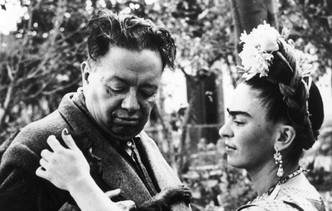About the tragic love story of two famous Mexican artists Frida Kahlo and Diego Rivera, dozens of books have been written and an Oscar-winning Hollywood drama starring Salma Hayek has been shot. But there is another important lesson that Frida taught in a little-known short text that she dedicated to her husband. We present to you this touching letter from a loving woman, which once again proves that love does not transform, it takes off the masks.
They married when Kahlo was twenty-two and Rivera was forty-two, and remained together until Frida’s death twenty-five years later. Both had numerous novels: Rivera — with women, Frida — with women and men, the brightest — with the singer, actress and dancer Josephine Baker and Lev Trotsky. At the same time, both insisted that their love for each other is the main thing in their lives.
But perhaps nowhere is their unconventional relationship more vivid than in the verbal portrait that was included in the foreword of Rivera’s book My Art, My Life: An Autobiography.1. In just a few paragraphs describing her husband, Frida was able to express all the greatness of their love, capable of transforming reality.

“I warn you that in this portrait of Diego there will be colors with which even I myself am not yet too familiar. In addition, I love Diego so much that I can not objectively perceive him or his life … I can’t talk about Diego as my husband, because this term in relation to him is absurd. He never was and never will be anyone’s husband. I cannot speak of him as my lover, because for me his personality extends far beyond the realm of sex. And if I try to talk about him simply, from the heart, everything will come down to describing my own emotions. And yet, given the obstacles that feeling imposes, I will try to sketch his image as well as I can.
In the eyes of Frida in love, Rivera — a man unattractive by conventional standards — is transformed into a refined, magical, almost supernatural being. As a result, we see not so much a portrait of Rivera as a reflection of the amazing ability of Kahlo herself to love and perceive beauty.
He looks like a huge baby with a friendly but sad face.
“Thin, sparse hair grows on his Asian head, giving the impression that they seem to be floating in the air. He looks like a huge baby with a friendly but sad face. His wide-open, dark and intelligent eyes are strongly bulging, and it seems that they are barely supported by swollen eyelids. They protrude like the eyes of a frog, separated from each other in the most unusual way. So it seems that his field of vision extends further than most people. As if they were created exclusively for the artist of endless spaces and crowds. The effect produced by these unusual eyes, so widely spaced, suggests the age-old oriental knowledge hiding behind them.
On rare occasions, an ironic yet tender smile plays on his Buddha lips. Naked, he immediately resembles a young frog standing on its hind legs. Its skin is greenish white like an amphibian. The only swarthy parts of his whole body are his hands and face, burned by the sun. His shoulders are like those of a child, narrow and rounded. They are devoid of any hint of angularity, their smooth roundness makes them almost feminine. Shoulders and forearms gently pass into small, sensitive hands … It is impossible to imagine that these hands could create such an extraordinary number of paintings. Another magic is that they are still able to work tirelessly.
I’m expected to complain about the suffering I endured with Diego. But I do not think that the banks of the river suffer because of the fact that a river flows between them.
Diego’s chest — we must say about it that if he got to the island ruled by Sappho, where male strangers were put to death, Diego would be safe. The tenderness of his beautiful breasts would have given him a warm welcome, though his masculine strength, peculiar and strange, would also have made him an object of passion in lands whose queens greedily cry out for masculine love.
His huge belly, smooth, taut and spherical, is supported by two strong limbs, powerful and beautiful, like classical columns. They end in feet that are planted at an obtuse angle and seem to be sculpted in order to place them so wide that the whole world is under them.
At the very end of this passage, Kahlo mentions an ugly and yet so common tendency to judge the love of others from the outside — a violent flattening of the nuance, scale and incredible richness of feelings that exist between two people and are available only to them alone. “Perhaps I am expected to hear complaints about the suffering that I experienced next to Diego. But I don’t think that the banks of a river suffer because a river flows between them, or that the earth suffers from rain, or that an atom suffers when it loses energy. In my opinion, natural compensation is given for everything.”
1 D. Rivera, G. March «My Art, My Life: An Autobiography» (Dover Fine Art, History of Art, 2003).










